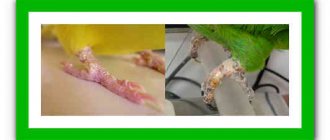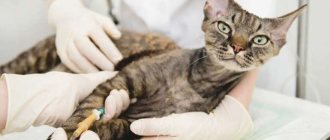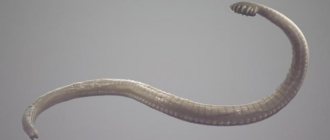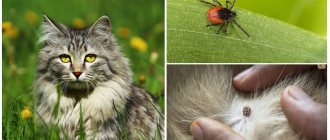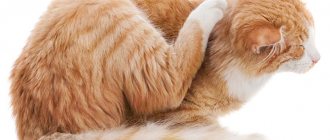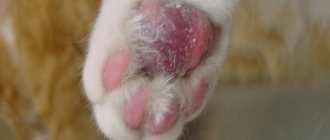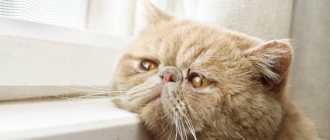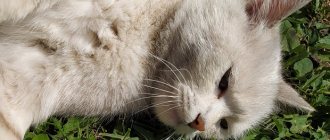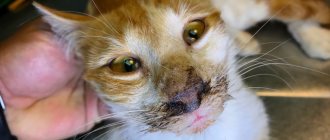12849Administration
1
Fungal infections in cats are quite common diseases. Spores of pathogenic fungi are carried by air and, if the animal’s immunity weakens, quickly lead to the development of disease. It is very important for owners to know the symptoms and treatment of fungus in cats, since only if therapy is started on time, they can eliminate the problem quickly and prevent serious harm to the pet’s health.
Cats always have fungal spores on their skin, and even a pet that does not leave the apartment has them. Being present in the animal normally, spores do not develop and do not lead to problems. If there is a violation of the skin condition, then, in addition to treating the lesion, therapy is also required to increase immunity . When a cat lives in the house, the budget must include an item for the cost of its treatment if necessary.
Routes of infection
The main carriers of pathogenic microscopic fungi are rodents and stray animals. The following factors contribute to their spread:
- high humidity;
- unsanitary living conditions;
- crowded keeping of pets.
Cats kept at home without walking can become infected with spores carried on the owners' clothes and shoes.
Those owners who use the services of zoo groomers should pay special attention to the sterilization of tools in salons, the use of disposable diapers, napkins and other hygiene items. If they get in small quantities on the intact skin of a healthy animal, spores do not develop. But when the cat’s immunity decreases, they become sharply activated and cause a clinical picture of the disease.
Reducing the level of resistance can be facilitated by:
- helminthiases;
- viral and bacterial infections;
- unbalanced diet;
- injuries;
- hypothermia or heatstroke;
- dysfunction of the endocrine glands;
- pregnancy and lactation period.
Small kittens are more often affected by dermatomycosis due to immature immunity. The period of weaning from the mother is especially dangerous, when babies stop receiving immunoglobulins in breast milk. It is well known that severe stress associated with a change of place of residence, the appearance of another animal or person in the house, aggression from people, can provoke a decrease in the cat’s body’s resistance to fungal infections .
Interesting! Not many people know that frequent conflicts in the family, divorce, long-term departure or depression of one of the owners has a very detrimental effect on the pet’s psyche, affecting its immunity and general health.
The presence of open wounds, abrasions, ectoparasite bites and other mechanical damage on the animal’s skin increases the risk of infection by pathogenic fungi.
What can lead to the formation of fungus
If we consider the picture as a whole, we can say that the appearance of nail fungus in cats (and not only it) occurs when the pet has physical contact with other representatives of its species.
In this case, even those cats that lead a domestic lifestyle are not insured, as they can pick up pathogens from the outdoor shoes and clothes of their owners.
This is especially true in rainy weather or in a house where there is a constant humid environment. In addition, you should be wary of minor injuries, diaper rash, etc.
The following factors can lead to the appearance of fungus:
- A young and fragile body;
- The period of lambing in a cat, when the body’s defense systems weaken;
- Decreased immunity due to the activity of a dangerous virus;
- Poor feeding;
- Carrying out immunosuppressive therapy;
- The influence of other serious diseases such as diabetes.
In some cases, diseases of this type may be asymptomatic, so they can only be detected after the hosts themselves have become infected. Very often children become the first carriers, as they most often play with pets.
Classification of fungal diseases
Diseases caused by pathogenic fungi are divided into 2 groups depending on the location of the lesion:
- superficial mycoses, the causative agents of which parasitize the skin and mucous membranes of animals;
- systemic mycoses that cause pathological changes in internal organs.
Diagnosis of the second group of diseases is difficult due to the lack of clinical symptoms characteristic of common fungal infections. Therefore, even signs of a cold or intestinal disorder should be a reason to contact a veterinary clinic, where an experienced doctor will be able to recognize the exact cause of the disease.
The most frequently reported fungal diseases include:
- ringworm caused by parasites of the genus Trichophyton and Microsporon;
- Malassezia, caused by the ear fungus Malassezia;
- aspergillosis, caused by saprophytes of the genus Aspergillus;
- candidiasis provoked by yeast fungi of the genus Candida;
- cryptococcosis caused by the saprophytic fungi Cryptococcus.
Important! Some of these diseases occur with damage to the nervous system, respiratory and digestive organs, so the lack of proper therapy can lead to death.
Of the hundreds of pathogenic species of fungi, it is worth highlighting those that are most often found in domestic cats. Despite the fact that the final diagnosis should only be made by a veterinarian, owners need to know the main signs of mycoses in their pets.
How is skin fungus treated?
Therapy for fungal diseases is long-term. It is unacceptable to end it without permission, deciding that the pet is completely healthy. Only a doctor can stop taking medications, since only tests can accurately determine whether the causative agent of the disease has been completely destroyed or whether it still partially remains in the tissues and the untreated animal will get sick again.
Poor quality treatment is the main reason for relapse of the disease.
If the cat's damage is particularly severe, not only ointments and gels can be used, but also injections and droppers. Very often it is also prescribed to wash the pet using special medicated shampoos that contain miconazole.
The following drugs are usually prescribed to treat fungal infections::
- Sulfuric ointment;
- iodine;
- brilliant green;
- antifungal vaccines;
- clotrimazole ointment,
- potassium iodide.
In cases where the fungus is systemic and damages the liver, kidneys, lungs and nervous system, the use of the antibiotic amoxicillin is indicated. It can be administered by injection, which will be quite difficult for owners who do not know how to give injections due to the high density of the drug , or administered orally. Medicine for injections is purchased at a veterinary hospital, and for oral administration in a human pharmacy, according to a veterinarian’s prescription.
Malassezia pathogen
The yeast-like fungus Malassezia pachydermatis is an opportunistic microorganism that is constantly present on the skin of healthy cats, but does not cause disease. Increased proliferation of fungi and the appearance of the clinical picture of malassezia occurs with a sharp decrease in the body's resistance, provoked by:
- poor diet;
- exhaustion;
- injuries or large blood losses;
- infectious and invasive pathologies;
- stress;
- allergic reactions;
- poisoning;
- scratches, burns, cuts and other skin damage.
Causes of fungal infection
Only a small part of fungi can cause disease in an initially strong and healthy animal. In general, mycoses are considered a sure indicator of some serious problems with the immune system.
A typical situation is when the disease developed against the background of long-term, continuous use of antibiotics or anti-inflammatory corticosteroids. Long-term use of immunosuppressants almost always leads to the same results.
If the animal’s immunity is relatively good, the infection is often localized. Otherwise, the fungi quickly take over the entire surface of the body.
Note that generalized mycoses (i.e., covering the entire surface of the body) are considered atypical for cats and are usually associated with some kind of severe immunodeficiency. The same cases include lesions of the claws: under normal conditions, fungi cannot “occupy” them.
Causative agent of aspergillosis
Saprophytic fungi of the genus Aspergillus are found in soil, rotting plant debris, and compacted rotted hay and straw. Cats are infected through direct contact with the pathogen in the external environment. At the same time, sick individuals are not carriers of the disease and are not dangerous to other animals and humans. Persian and Himalayan cats are predisposed to aspergillosis. Other pets become infected during periods of immunosuppression associated with other infectious diseases.
Fungal spores, falling on the mucous membranes of the nasal cavity or conjunctiva, penetrate the epithelial barrier into the tissue, destroy surrounding cells and suppress the action of phagocytes. Depending on the location, there are 2 forms of pathology:
- sinonasal;
- sinoorbital.
Symptoms of sinonasal aspergillosis (SNA)44
Types of infections
If a person suspects that his pet has picked up an infection somewhere, but is not completely sure, it is worth looking into the global web and looking for photographs of fungus in cats.
There you will also find information on various types of fungal infections:
- Aspergillosis;
- Ringworm;
- Cryptococcosis;
- Malassezia;
- Candidiasis and others.
Causative agent of candidiasis
Fungi of the genus Candida are part of the microflora that populates the skin and mucous membranes of cats. When the immune system is weakened or antibiotics are used for a long time, microorganisms begin to multiply intensively, causing erosive lesions, hair loss and other clinical signs.
Symptoms
The main locations of lesions are the abdomen, hips, shoulder blades and muzzle of the animal.
- Erosion and ulcers covered with yellowish films form on the mucous membranes and in the area of the external auditory canal.
- Their forced removal leads to the appearance of bleeding wounds.
- The skin lesions are scaly, round, gray alopecias.
- Severe itching leads to scratching, which quickly becomes infected with pyogenic microflora.
Treatment
Therapeutic measures to eliminate cutaneous candidiasis include the following:
- removal of hair and pieces of dead tissue in the affected area;
- bathing every 3 days using shampoo containing Ketoconazole, Miconazole or Chlorhexidine;
- lubrication of erosions with antifungal ointments;
- the use of oral medications in case of generalization of the process.
In case of damage to the mucous membranes, irrigation with a solution of Clotrimazole is used at intervals of 6-7 hours.
Photo of fungus in cats
Ringworm in cats - main signs, symptoms, prevention and treatment of ringworm in cats (105 photos)Pancreatitis in cats: first symptoms, nutritional nuances and treatment options (125 photos and videos)
Subcutaneous mites in cats - first symptoms, treatment options and real photos of examples of parasite damage (110 photos + video)
Read here Tartar in cats - signs of the disease and methods of fully treating tartar (125 photos + video)
Help the site, share with friends 
Causative agent of cryptococcosis
Carriers of the yeast-like pathogenic fungi Cryptococcus neoformans are wild and domestic birds. Cats become infected by inhaling spores of the pathogen when sniffing droppings, bedding or other objects that have previously been in contact with carriers.
It is believed that a person cannot become infected with cryptococcosis from their pet. But experts advise following hygiene rules, since the potential possibility cannot be completely ruled out.
Symptoms
There are 2 forms of the disease depending on the location of the pathological process.
- The nasal form of cryptococcosis is manifested by signs of rhinitis, cough, purulent discharge from the eyes. If left untreated, inflammation spreads to the meninges, causing meningitis.
- The skin form leads to the appearance of small nodules on the nose, gradually turning into purulent ulcers.
Treatment
Therapy is reduced to the use of oral and external antifungal drugs. It is advisable to additionally treat foci of purulent inflammation with antibacterial ointments or sprays.
Is fungus dangerous for humans?
The fungus is not often transmitted to humans, but it does happen, and it is best to protect yourself from the disease.
Fungal spores are found on the animal’s fur, which it picks up on the street, from other animals, as well as from humans, which it can easily bring into the home.
Therefore, maintaining hygiene is of particular importance.
If fungus is detected in your cat, an immediate visit to the veterinarian is necessary, who will give you recommendations on how to protect yourself from infection.
If you have been bitten or scratched with its claws by an unfamiliar cat, you should immediately contact a medical facility in order to eliminate an accidental infection with a fungus.
Causes of dermatitis
It is impossible to become infected with Malassezia, since it is normally found on the skin of any healthy cat, so the cause of fungal dermatitis is caused by excessive, pathogenic proliferation of the fungus. A signal for its reproduction may be a decrease in the protective properties of the cat’s skin under the influence of various factors - allergies, decreased immunity, flea and tick bites, constant exposure to a humid environment (usually this is typical for stray cats that live in basements during the cold season), etc.
